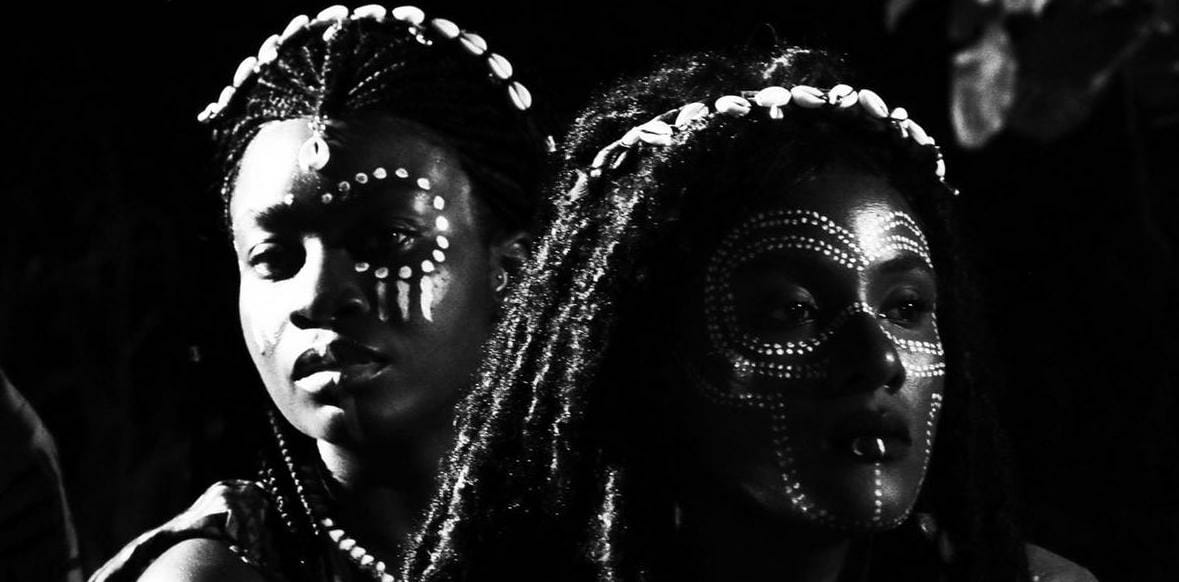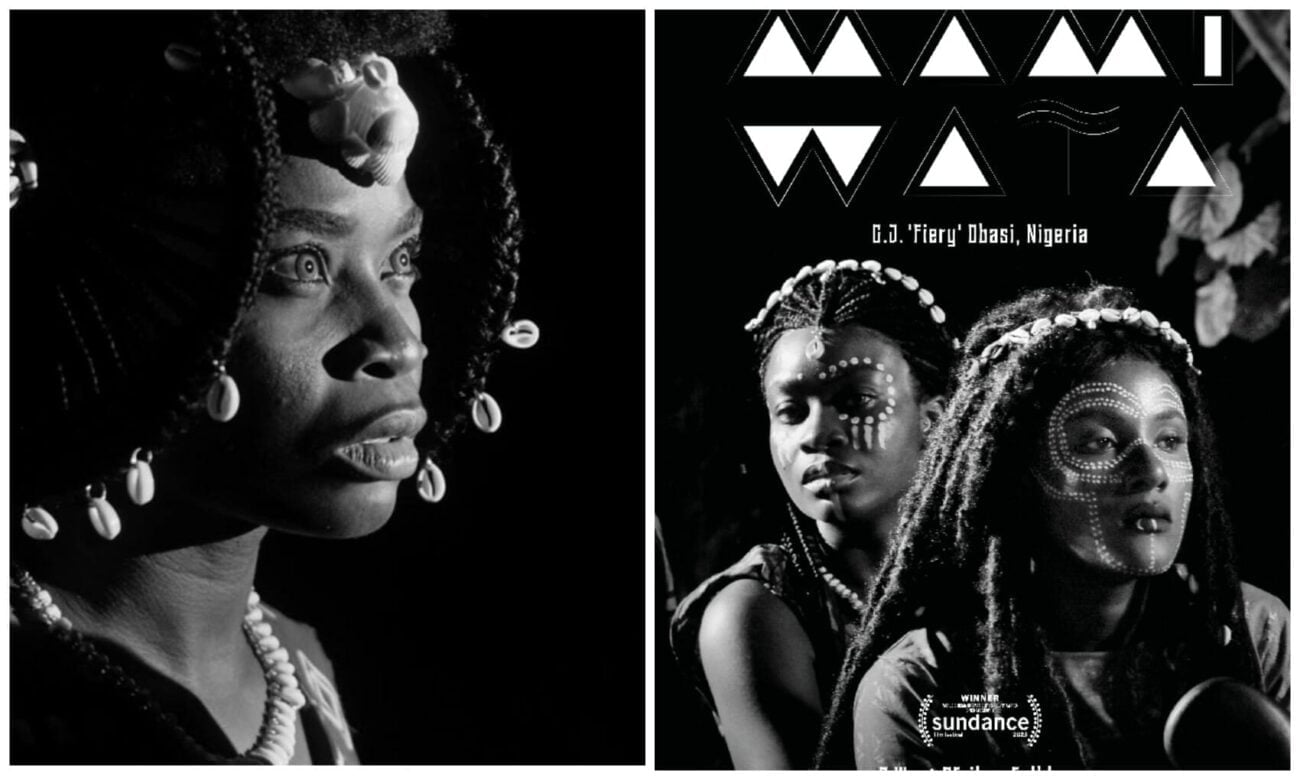C.J. Obasi’s latest creation, “Mami Wata,” emerges as a mesmerizing black-and-white fantasy drama that delves deep into the heart of West African mythology, politics, colonization, and spirituality.
Produced in collaboration with Guguru Studios, Ifind Pictures, and Fiery Film Company and spearheaded by Obasi’s wife, Oge Obasi, this cinematic gem made its highly-anticipated debut on September 8th, 2023, in cinemas.
The film boasts an ensemble cast of seasoned actors, including Rita Edochie, Evelyne Ily, Uzoamaka Aniunoh, Emeka Amakeze, Kelechi Udegbe, and Tough Bone.

“Mami Wata” Story
Set against the backdrop of the enchanting Benin Republic, “Mami Wata” follows the captivating tale of Prisca (Evelyne IIy) and Zinwe (Uzoamaka Aniunoh), the daughters of Mama Efe (Rita Edochie), who serve as the intermediary between the Mermaid goddess Mami Wata and the people of Iyi, a tranquil fishing village in West Africa. Their lives take an unexpected turn when Jasper, a formidable mercenary, seizes control of Iyi.
The gripping narrative unfolds as Mama Efe faces the threat of a coup, and the sisters must reclaim their birthright. Will Mama Efe survive the coup? Will the sisters reclaim their birthright? Will the goddess herself show up to save her devoted followers? You should head to the cinema to find out like I did.
Riveting Performances: The Talented Cast of ‘Mami Wata’
From the very beginning, “Mami Wata” enthralls audiences with its cast, each actor seamlessly embodying their characters. From Mama Efe’s quiet dignity to Evelyne IIy delivering a remarkable portrayal of Prisca, the warrior princess who exudes both beauty and sass.
However, it’s the dynamic performances of the sisters Prisca and Zinwe that anchor the film. Their quiet yet unwavering conviction shines brightly, complemented by Emeka Amakeze’s brash yet imposing character Jasper. The movie stands as a testament to the talent that graces its screen.
The Artistry of Costumes and Makeup
What sets “Mami Wata” apart is the meticulous attention given to its majestic sculptural hairstyles, stylized makeup, and imaginative costuming. The film’s creators pay homage to tradition with fabrics adorned in bold, repeating geometric patterns, expertly woven into the narrative’s visual tapestry.
Costume designer Bunmi Demiola Fashina, key makeup artist Campbell Precious Arebamen, and key hairstylist Adefunke Olowu receive well-deserved recognition in the end credits, shining a light on their invaluable contributions.
Use of Language and Thematic Preoccupation
While “Mami Wata” unfolds in the present day, its themes resonate as timeless echoes of history. The narrative subtly explores themes of patriarchy, colonization, the erosion of tradition, and the pragmatic choices necessary for African villages to survive. Director C.J. Obasi, renowned for his exploration of African folklore and mythologies, weaves a masterful tapestry.
The film employs a rich tapestry of languages, including Fon, West African pidgin English, and English, to poignantly examine the clash between tradition and modernity. It’s a subtle yet powerful commentary on colonization, embodied by Jasper, who arrives from the West with promises of progress but ultimately exploits the village for personal gain.
The villagers predominantly speak Fon and pidgin English, while the English Language is primarily employed by Jasper, an outsider hailing from the Western world. Jasper’s attempt to impose modernity upon the people of Iyi carries echoes of Obasi’s exploration of colonization. Through Jasper’s actions, including recruiting Jabi’s zealots as guards and making enticing promises of medicine, roads, and electricity while diverting funds and offerings to acquire weapons, Obasi mirrors the historical narrative of colonization.
Jasper’s crucifix necklace serves as a deliberate symbol, symbolizing how the arrival of Europeans to Africa led to the displacement of indigenous beliefs and practices, particularly those with matriarchal foundations. It vividly portrays how Jasper, as the embodiment of modernity and colonization, seduces Prisca, a princess from the Iyi village, and subsequently turns violently against her.
In “Mami Wata,” Obasi underscores the strength of women and challenges the prevailing rule of patriarchy. Female authority takes center stage throughout the movie, from Mama Efe to Prisca, Zinwe, and Mami Wata herself. The battle between patriarchy and matriarchy unfurls, and one powerful scene resonates as Prisca defiantly states, “You suppose dey fear woman,” highlighting the story’s exploration of female empowerment.
Cinematography in ‘Mami Wata’
Beyond its narrative brilliance, “Mami Wata” shines most brightly in its visual storytelling. Cinematographer Lílis Soares masterfully captures the essence of the ocean, which stands as a prominent character in the film. Through a series of well-composed black-and-white shots, the ocean appears as textured glass and water droplets on the skin glisten like glitter.
The cinematography breathes magic and mythology into the human world, expressed through stunning hair, makeup, and costumes that create a dreamlike atmosphere. It’s a visual feast that exudes confidence, celebrating the rich tradition of femininity, purity, and the sea.
“Mami Wata” may bear the film’s title, but it’s the water that truly steals the spotlight. The film’s unconventional monochromatic style, juxtaposing jet-black nights with blanched white days, sharply defines the lead characters against these backdrops, lending them an otherworldly quality.
Despite the film’s predominantly nocturnal setting, some fight scenes are challenging to discern due to the deep darkness. However, this unconventional monochromatic shooting style, where nights are jet black and sunny days are blanched white, sharply defines the lead actors against these contrasting backdrops. Their distinctive hairstyles, face decoration, and clothing look almost otherworldly, contributing to the film’s artistic and distinctive visual effect.
Overall, the cinematography in “Mami Wata” elevates the film to a visual masterpiece, creating an unforgettable and immersive viewing experience.
In crafting “Mami Wata,” C.J. ‘Fiery’ Obasi has not only delivered a remarkable cinematic experience but also contributed a milestone to Nigerian cinema. This film beckons Nigerian filmmakers to explore their unique stories, elevate their cultural identities, and craft narratives that resonate globally while captivating audiences with visually appealing storytelling.
Although “Mami Wata” may have minor narrative and pacing hiccups, its outstanding performances and visually sumptuous presentation make it a formidable cinematic achievement.
In this reviewer’s eyes, it deserves a solid 8/10, a testament to its significant impact on Nigerian cinema.







